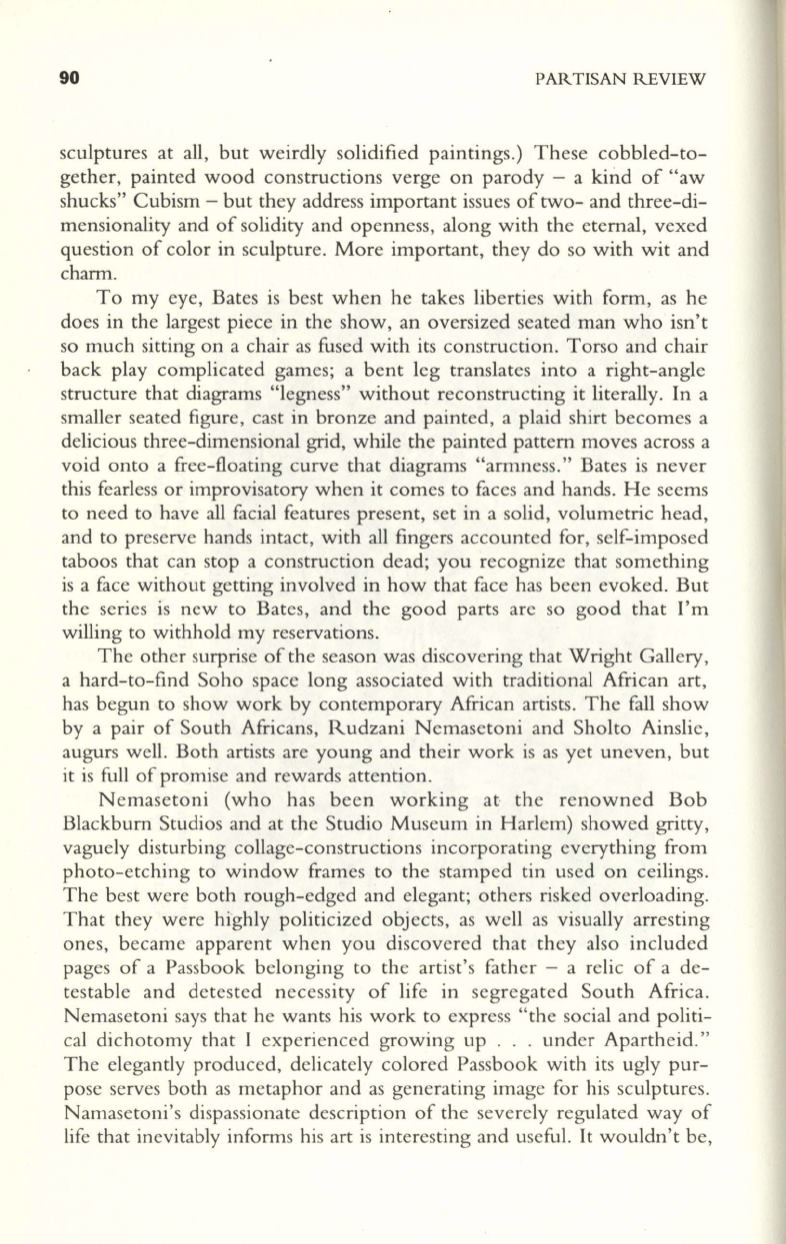
90
p
ARTISAN REVIEW
sculptures at all, but weirdly solidified paintings.) These cobbled- to–
gether, painted wood constructions verge on parody - a kind of "aw
shucks" Cubism - but they address important issues of two- and three-di–
mensionality and of solidity and openness, along with the eternal, vexed
question of color in sculpture. More important, they do so with wit and
charm.
To my eye, Bates is best when he takes liberties with form, as he
does in the largest piece in the show, an oversized seated man who isn't
so much sitting on a chair as fused with its construction. Torso and chair
back play complicated games; a bent leg translates into a right-angle
structure that diagrams "legness" without reconstructing it literally. In a
smaller seated figure, cast in bronze and painted, a plaid shirt becomes a
delicious three-dimensional grid, while the painted pattern moves across a
void onto a free-floating curve that diagrams "armness." Bates is never
this fearless or improvisatory when it comes to faces and hands. He seems
to need to have all facial features present, set in a solid, volumetric head,
and to preserve hands intact, with all fingers accounted for, self-imposed
taboos that can stop a construction dead; you recognize that something
is a face without getting involved in how that face has been evoked. But
the series is new to Bates, and the good parts are so good that I'm
willing to withhold my reservations.
The other surprise of the season was discovering that Wright Gallery,
a hard-to-find Soho space long associated with traditional African art,
has begun to show work by contemporary African artists. The fall show
by a pair of South Africans, Rudzani Nemasetoni and Sholto Ainslie,
augurs well. Both artists are young and their work is as yet uneven, but
it is full of promise and rewards attention.
Nemasetoni (who has been working at the renowned Bob
Blackburn Studios and at the Studio Museum in Harlem) showed gritty,
vaguely disturbing collage-constructions incorporating everything from
photo-etching to window frames to the stamped tin used on ceilings.
The best were both rough-edged and elegant; others risked overloading.
That they were highly politicized objects, as well as visually arresting
ones, became apparent when you discovered that they also included
pages of a Passbook belonging to the artist's father - a relic of a de–
testable and detested necessity of life in segregated South Africa.
Nemasetoni says that he wants his work to express "the social and politi–
cal dichotomy that I experienced growing up ... under Apartheid."
The elegantly produced, delicately colored Passbook with its ugly pur–
pose serves both as metaphor and as generating image for his sculptures.
Namasetoni's dispassionate description of the severely regulated way of
life that inevitably informs his art is interesting and useful. It wouldn't be,


